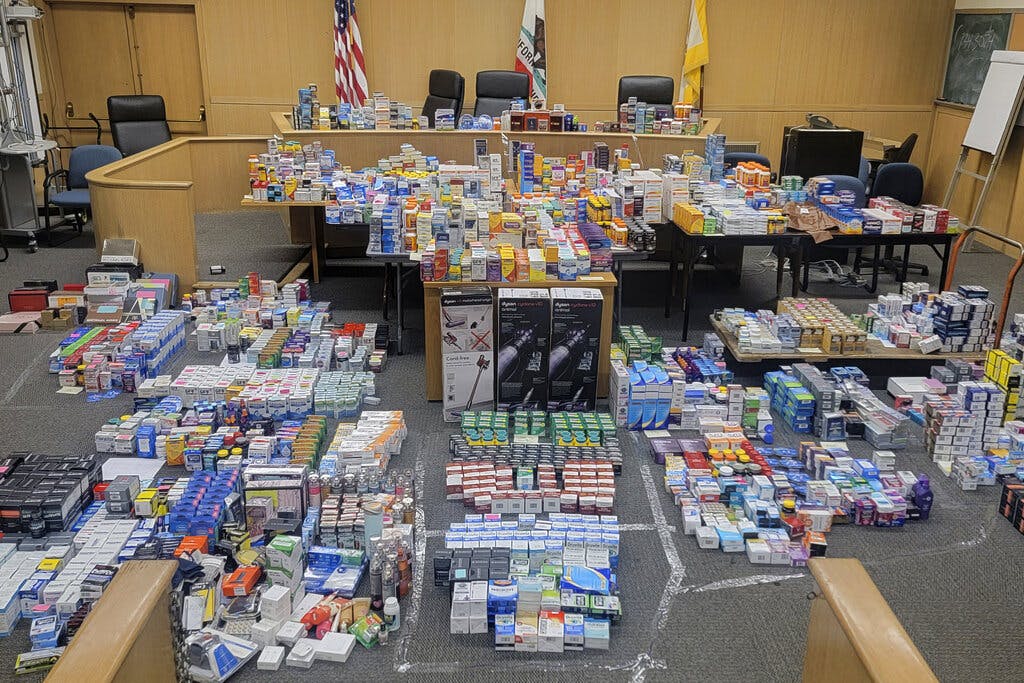Organized Gangs Behind Increasingly Violent Theft Rings Plaguing American Cities, Retailers Say
Retailers say a growing youth subculture that celebrates ‘boosting’ from stores on social media is exacerbating the problem.

A new report by a retail trade association says shoplifting, often described by reform-minded liberals as a “victimless” crime of necessity, is becoming a bigger and more dangerous problem in America, with organized criminal gangs using increasingly violent tactics to steal and resell goods.
The report from the National Retail Federation said members surveyed by its authors reported an average 26 percent increase in theft in 2021, and 70 percent of them said the problem has gotten worse in the past five years. The federation says the crime costs retailers nearly $100 billion a year, and about half of that figure is attributable to what it calls “organized retail crime.”
“Organized retail crime remains a persistent threat to the retail industry, accounting for more than $94.5 billion in losses in 2021,” the National Retail Federation’s David French said. “These sophisticated crimes permeate the entire retail ecosystem, impacting consumers, employees and communities nationwide.”
Organized retail crime, the federation says, differs enormously from shoplifting, which usually involves one person stealing items for personal use. The gangs behind organized retail crime are sophisticated organizations with logistics and transportation networks and well-defined job responsibilities for their members — “boosters” to steal the goods, “cleaners” to remove security tags, and fences to sell the items.
Four out of five of these organized gangs studied by the federation concentrate on everyday consumer goods such as cosmetics, over-the-counter medicines, and personal care items, mainly because they are easy to resell on online marketplaces such as Facebook Marketplace and Craigslist. The study includes one such Facebook listing from the Oklahoma City area that brazenly pictures a resident’s garage filled to the rafters with diapers, laundry detergent, razors, and other everyday items for sale.
In previous years, shoplifting was usually a nonviolent crime. Recently, though, the gangs are becoming more violent, according to the study, relying on flash mobs, smash-and-grab tactics, and threatening customers and employees. On Wednesday, a 26-year-old staffer at a Home Depot in the San Francisco Bay area was shot and killed when he attempted to confront two shoplifters at the store.
The increasingly rampant retail theft has forced retailers in several large American cities — Portland, San Francisco, and Seattle to name just a few — to abandon their stores out of concern for the safety of their employees. Those that remain are increasingly displaying even relatively inexpensive everyday goods such as razors and deodorants in locked cases.
A couple of bills currently before Congress are aimed at trying to rein in the burgeoning industry. Members in the House earlier this year introduced the Combating Organized Retail Crime Act that would establish a special division within the Department of Homeland Security to tackle the problem. A companion bill in the Senate enjoys broad bipartisan support.
“The disturbing explosion of organized retail crime across the country these past couple of years has seriously harmed businesses — large and small — putting communities at risk,” one of the bill’s sponsors, Ken Buck, a Republican of Colorado, said. “There is still much we don’t know about the depths of these criminal organizations, this bill would help us get to the bottom of it.”
The retail federation’s study suggests that the problem is likely to get worse before it gets better. Persistent inflation and a worsening economy are likely to steer more price-sensitive shoppers to illegitimate “retail” outlets like the garage at Oklahoma City.
The report says a growing youth subculture that celebrates “boosting” or “borrowing” items from stores on social media outlets like TikTok, often in tandem with anti-capitalist rhetoric, has reduced the stigma associated with crimes like shoplifting and retail theft, also contributing to the overall growth of the problem.
“People give way too much crap to people who lift from big name capitalist stores,” one post from Tumblr cited in the study said. “What most of you fail to realize is that this crap is worth practically nothing. These companies make huge profits off of minimum wage employees and selling cheap crap for 10 times what it is worth.”

